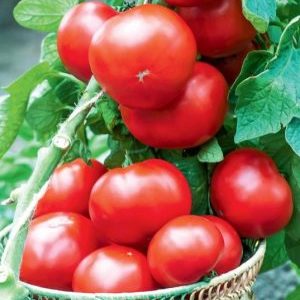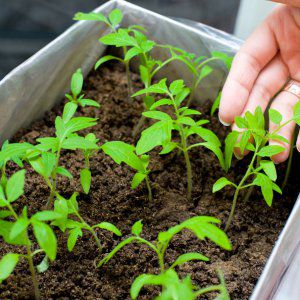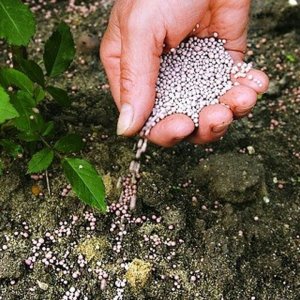An excellent choice for those who want to get a rich early harvest of excellent tomatoes - tomato "Bogata Khata F1"
Summer residents are always interested in cultivating new varieties of tomatoes. The Bogata Khata hybrid is perfect for growing even for inexperienced gardeners. The crop gives a quick and high-quality harvest without much time and effort. Experienced vegetable growers speak very positively about Bogata Khata tomatoes.
The content of the article
Description of the variety
The hybrid was bred by Ukrainian breeders in 1997. In the Russian Federation, the tomato was officially registered in 1999.
Bogata khat tomatoes belong to determinant type of plants. The maximum height of the standard bush does not exceed 35-40 cm. The culture, although undersized, is very strong. The carved foliage is light green and medium in size. The inflorescence is simple, up to 5 flowers are laid in it. The fruit cluster is strong, well developed, bearing 3-5 small tomatoes. The compact plant does not give rise to stepchildren, which greatly simplifies its cultivation.
Distinctive features
The hybrid has a tremendous vitality that cannot be compared with ordinary varietal tomatoes. The rich hut F1 grows quickly, has a strong immunity to diseases and pests, and gives an excellent harvest. The culture is grown both in a greenhouse without heating, and in the open field and even on a balcony.
Fruit characteristics and yield
Tomatoes are dense, rounded-even, bright red. When cut, the tomato has pink-red flesh and 5 seed chambers. The fruits ripen 95-105 days after germination. The weight of a tomato reaches 100-120 g. Vegetable growers collect up to 8 kg of harvest from one square meter.
The fruits have a pleasant taste and aroma. The use of tomatoes is universal. The peel is thick, does not crack, so tomatoes tolerate transportation well and are stored for a long time.
How to grow seedlings
To obtain an earlier harvest, Bogata Khata F1 tomatoes are grown through seedlings. The seeds are sown in small containers with fertile soil. When the plants at home get stronger, they are transplanted to a permanent place of growth.
Seed preparation
First of all, pay attention to the presence of a stamp on the package with seeds. It indicates whether the producer has previously processed the seed. Untreated seed is sometimes sold. In this case, the preparation is carried out independently. For this, a special solution is prepared, which includes one of the following substances:
- potassium permanganate;
- aloe juice;
- Fitosporin.
The seeds are kept in the composition for 5-8 minutes, then thoroughly washed under running water. Grains are not planted wet. They dry well, and only then will they be suitable for planting.
Capacity and soil
The most popular container for growing tomato seedlings is sphagnum peat cups or tablets (sphagnum reliably protects the roots from decay). During transplantation, tomato seedlings are transferred into prepared holes along with a peat container. This prevents damage to the roots, and the container itself gradually dissolves into the soil.
They also make containers on their own. The most suitable are plastic cups or cut plastic bottles. Also, cardboard boxes for juice or milk are cut to the required level. The most suitable volume of an improvised container is 0.5 liters, with such a capacity, diving is not performed.If 100 ml cups are used, the seedlings are grown until 2-3 true leaves appear.
When transplanting to a permanent place, the seedlings are taken out of a plastic cup along with the soil.
Important! When using plastic or other homemade containers, drainage holes are made at the bottom so that excess liquid does not accumulate after watering the seedlings.
Sowing
Seeds for seedlings are planted in late March - early April. The grains are laid to a depth of 1.5-2 cm, then the container is covered with transparent glass or film and left in this form until the first shoots appear. After that, the seedlings are transferred to the lightest windowsill or illuminated with phytolamps.
On a note. Even the smallest drafts can destroy young shoots, as the soil in the containers cools quickly. Therefore, take care of airing the room in advance without damaging the plants.
Growing and care
For the good development of tomato seedlings at home, it is necessary to provide:
- regular soil moisture;
- illumination of plants for 11-13 hours;
- daytime air temperature 18-20 ° С;
- the temperature at night is not lower than 16 ° C.
The container with the plants is kept on the windowsill. The container is placed on a foam base, which protects the seedlings well from the cold.
With a short daylight hours over the tomatoes, the illumination in the form of phyto- or fluorescent lamps is evenly placed. Lighting is turned on in the morning or evening.
Water tomato seedlings only with warm and settled water. The soil is always kept moist. When the tomato stalks grow up, they are carefully spud.
After the formation of 1-2 leaves, the tomatoes are transplanted into separate containers. Two weeks before transplanting plants to a permanent place, the seedlings begin to harden. To do this, they take it out on the street or balcony every day: in the first days for 2 hours, then the time the plants stay in the fresh air is gradually increased.
How to grow tomatoes
Proper cultivation of tomatoes Bogata Khata consists in timely moistening, loosening the soil and periodically weeding the beds from weeds. Although the culture has good resistance to diseases, gardeners still treat the soil with a weak solution of potassium permanganate.
Landing
Seedlings are transplanted to the garden bed 60 days after sowing the seeds. Work is carried out when the soil warms up well, in May - June. The plot for tomatoes has been prepared since autumn. The culture is demanding on the fertility of the soil and the abundance of sunlight. Crop rotation is also important for tomatoes.
Good predecessors for culture:
- garlic;
- onion;
- cabbage;
- legumes.
Unwanted predecessors:
The soil is dug up and added to 1 sq. m 3-4 kg of compost and 25 g of superphosphate and potassium salt. In the spring, the soil is loosened with a rake.
Tomatoes are planted in 20-centimeter holes at a distance of 40 cm from each other, and a gap of 50 cm is left between the rows. The roots are covered with earth and watered abundantly.
Care
With regular maintenance, the culture develops well. Plants are watered and fertilized in a timely manner. The undersized variety does not need pinching. When fruiting, only the lower leaves are cut off.
Plants are tied to a small wooden or metal support. To prevent diseases and pests, the culture is sprayed with biological products. In greenhouse conditions, the humidity level is controlled by opening or closing two opposite windows and doors.
The frequency of watering is set depending on the weather conditions and the stage of crop development. After planting in a permanent place, the tomatoes are watered, then they are allowed to adapt for 7 days, during this period the culture is not moistened.
Before the formation of ovaries, every 4 days, add 2 liters of water to the bush. During flowering, plants require more moisture, 5 liters of water are consumed per bush. With mass fruiting, watering is reduced. They do this so that the fruits do not crack.
Important! Water the culture with warm water, which is poured strictly under the root in the morning or evening.
After watering the plants, the soil around the tomatoes is loosened and weeds are removed at the same time. If tomatoes are grown in a greenhouse, it must be ventilated. The moisture content of the soil is maintained by mulching the beds with humus or peat.
For a high yield of the Bogata Khat hybrid, fertilizers must be applied in a timely manner. Top dressing of tomatoes is made with solutions based on mineral or organic substances.
Tomatoes are fertilized according to the following scheme:
- after 10 days after planting plants in a permanent place;
- during the formation of buds;
- with the appearance of the first fruits;
- during the period of mass fruiting.
In the early stages of development, tomatoes are fed with mullein. It contains nitrogen, which contributes to the formation of new shoots.
The next feeding is carried out with solutions that contain potassium sulfate and superphosphate. In 10 liters of water, stir 25 g of each substance. The resulting fertilizer is applied under the root of the tomatoes.
In cool weather, foliar (foliar) feeding is used. The solution is prepared from phosphorus and potassium substances. 10 g of each fertilizer are stirred in 10 liters of water. The culture is sprayed in the morning or evening.
Mineral and organic tomato feed alternates. The day before watering, ash is added to the water. Also, as a fertilizer, it is embedded in the soil during loosening. Wood ash saturates the culture with a complex of mineral substances.
Features of cultivation and possible difficulties
Cultivation of Bogata Khata tomatoes is no different from cultivation of other hybrid tomatoes. Although the plant has a good immune system, some difficulties can still arise in growing vegetables. Each gardener plants a crop in his own way, besides, the structure of the land is different everywhere. Because of this, various problems arise.
When a plant has flowers and ovaries crumbled, it means that the bushes do not have enough moisture or nutrition. To eliminate the problem, the soil is regularly moistened with warm water. Depending on weather conditions, the amount of watering varies.
When growing tomatoes in a greenhouse, the cause of this problem is a lack of ventilation or rotting of the fruit. Airing and systematic irrigation should be monitored.
Diseases and pests
The tomato has excellent resistance to disease-specific diseases. If the crop is affected by any disease, it means that the plants are receiving the wrong care. Possible diseases:
- Dry spot is a fungal disease that is treated by spraying with fungicides and antifungal agents.
- Cracking of tomatoes. This is due to improper watering. In this case, their frequency is reduced.
Pests and control of them:

- Scoop... Since this insect does not like medicinal plants, calendula is planted next to the tomatoes. The bushes are sprayed with garlic infusion (200 g of grated garlic or onion is mixed well in 10 liters of water and allowed to brew for a day). Of the chemical preparations, the Intavir agent is used.
- Slugs... In the fight against this parasite, the soil around the plants is sprinkled with ash, lime, makhorka or tobacco crumbs. Also, weeds are removed in a timely manner and a garden bed with tomatoes is mulched.
- Colorado beetle... They get rid of the pest by spraying with an infusion of walnut leaves, wormwood, garlic, elecampane or hemp. The procedure is carried out once a week, the last one - 3 weeks before harvesting.
It's important to know! A soap solution is added to any of the above means for stickiness: the grated soap is dissolved in a container with water.
The nuances of growing in open ground and in a greenhouse
Tomato Bogata khata is grown outdoors in the southern regions. In the middle lane, film shelters are used. In more northern regions, the hybrid is cultivated in greenhouse facilities.
Harvesting and application of the crop
The crop ripens in June - August.The bushes should be checked daily for ripe fruit.
The use of vegetables is universal - they make tomato juice, sauce. Due to the small size of tomatoes, tomatoes are great for canning and barrel pickling. They are also consumed fresh as an addition to various dishes.
Advantages and disadvantages
Vegetable growers prefer this hybrid for its positive qualities:
- early maturity;
- high productivity;
- the ability to grow even on the balcony;
- transportability of fruits;
- long-term storage;
- resistance to temperature changes;
- good immunity to diseases;
- excellent taste;
- versatility in application;
- compactness of bushes.
The main disadvantage of the F1 hybrid is that seeds cannot be harvested from their own harvest. Also, some gardeners are not satisfied with the size of the fruits, but this drawback is compensated by the fact that the tomato is excellent for conservation.
Reviews
Vegetable growers respond positively to Bogata Khata tomatoes. This hybrid has more advantages than disadvantages.
Anna, Bryansk: «A neighbor in the country always praised her tomatoes. I also decided to grow a hybrid of tomatoes Bogata Khata. Seedlings appeared quickly, the culture was grown in a greenhouse. The plant is quite fruitful for its size. The fruits are delicious and aromatic. Compact bushes save a lot of space in the garden. I prepared so much preservation that I then handed it out to relatives. I really liked the hybrid, I will continue to plant it. "
Svetlana, Ufa: “I have been growing tomatoes for sale for several years in a row. I always buy new yielding varieties that do not require special care. According to the characteristics, I chose the hybrid Bogata Khata I liked that the culture refers to early ripening tomatoes. The fruits have an excellent presentation, as in the photo of the package with seeds, and most importantly, they are stored for a long time. "
Conclusion
Hybrid Bogata Khata is a real find for novice vegetable growers. This culture is unpretentious to care for and gives a bountiful harvest on fertile soil. If you do not have a summer cottage, this tomato is well suited for growing on a balcony or loggia. The fruits have a classic look and are stored for a long time.
You will learn more information about the Bogata Khata hybrid in the following video: